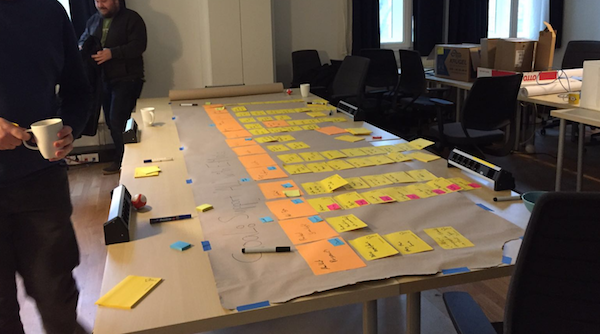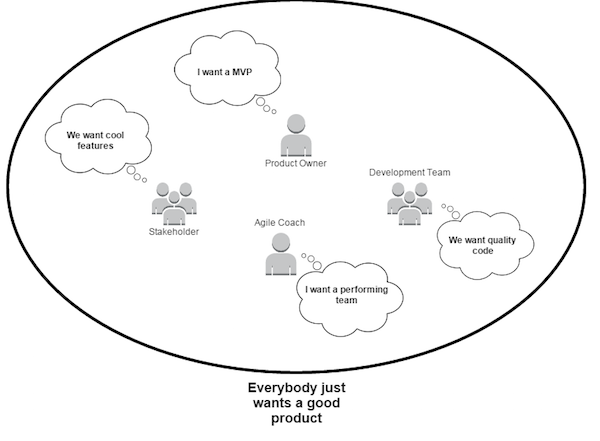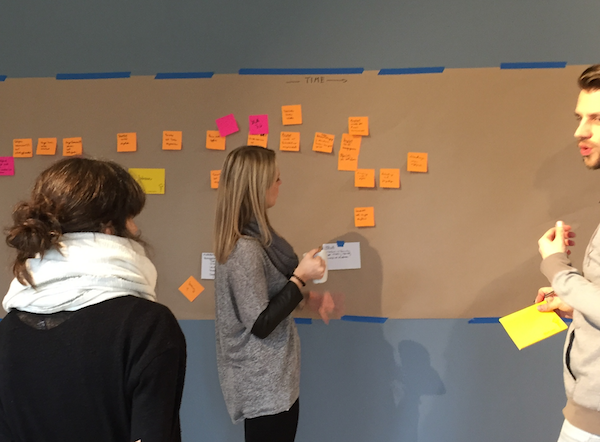Stakeholder collaboration
2016-09-19
The Product Owner is often meant to be the translator between the business language and the technical language of the developers. I think this is fundamentally wrong. Instead of looking for a translator teams should establish a ubiquitous language that both sides can understand to enable direct communication.
In my career so far, i was responsible for a couple of different products. I would like to share my experience in terms of the collaboration with the stakeholders for two of these projects. Both were very different.
The Marketing Backend
The Marketing Backend is a reporting tool for performance marketing KPI’s aggregated on monthly cohorts. The tool is used by marketing key account managers to steer marketing investments aligned by the life time value per customer.
Stakeholder:
Around 30 key account manager are using the tool on a daily basis. The requirements came from one key user per marketing team (SEA, Facebook, Display, RTA, TV).
Development Team:
- 7 Developers
- 1 QA
- 1 Product Owner (me)
- 1 Agile Coach
The Customer Relationship Management (CRM) System
The task here is to provide customer data to a third party system that is required to communicate with the customers for marketing purposes. In the first step the team focuses on email marketing.
Stakeholder:
Requirements are worked out together with two email marketing managers. Besides that developers, who are using the data interface, are considered as stakeholder as well.
Development Team:
- 3 Developers
- 1 Product Owner (me)
- 1 Agile Coach
Aspects of Collaboration
Collocation
Marketing Backend
The development team was separated from the stakeholders. For some period of time the separation was even over different buildings. A casual exchange between them was only possible in official meetings. The stakeholders were always considered as disruptive and direct communication with them was avoided.
CRM
Developers and stakeholders are sitting together at the same table. They consider themselves as one team. Issues related to their work are usually clarified directly. Both sides see what is their daily business and that fosters a mutual understanding and the willing to work collaborative together.
Lessons learned
Direct communication between developers and stakeholders is essential for a successful product development. The example shows that a spatial separation of development team and stakeholders is a huge weakening of the communication flow.
Integration of stakeholders into the scrum process
Marketing Backend
The requirements were communicated to the team with Jira tickets. Stakeholder and Product Owner met two times a week to refine these tickets. Besides that there was a bi-weekly prioritization meeting also just between stakeholders and Product Owner. Information about requirements and prioritization was communicated to the development team by the Product Owner. There was no review meeting. Instead tickets were assigned back to the stakeholders for approval after implementation. Due to that developers got very delayed feedback about their work and the backlog was rapidly growing to a size that was not manageable anymore.
CRM
Developers and stakeholders are doing their daily stand up together. Here they share details about the work and potential problems. Stakeholders also participate to the sprint planning and developers ask them directly for advice. Priority and product strategy are discussed on a higher level with a goal oriented roadmap. The roadmap is also maintained by all involved people together on a regular basis. There is a review meeting after every sprint were the development team collects feedback about their current iteration from a extended circle of stakeholders.
Lessons learned
It is mandatory for the developers to get early feedback about their current work from the stakeholders. The Product Owner should never be a buffer between the team and the stakeholders. Rather he must take care that both sides are connected and that they clarify issues on their own.
Domain Knowledge sharing
Marketing Backend
The domain “performance marketing” was a complete new topic for the development team. They had a lot of trouble to get into that. In some cases the developers even refused to learn something about their domain. They expected that the Product Owner will tell them what needs to be done. This lead to the fact that a lot of iterations were needed to come to a suitable solution for many requirements.
CRM
Also in this case the domain was completely new for the team. But this time the team did not refused to learn. The developers had an interest in the work of the stakeholders. They are often sitting together and let the stakeholders explain their work. As a kick off we did a Story Mapping workshop. Here we worked out together the complete email marketing workflow. In that way basic question could be asked before we started the work.

Lessons learned
To solve the problems of the business it is required to understand the business needs. It is mandatory to inspire curiosity for the business side from the beginning on, so that developers are willing to learn what they needed to know for building their product. It is the task of a product owner to foster that process and again to connect both sides.
Shared Commitment
Marketing Backend
The “big picture” and the value of the product for the company was not transparent for the development team. As a result of that the team withdraw to an area where they felt comfortable, which was software architecture and design patterns. In the end this lead to overengineering. Stakeholder on the other side did not had any appreciation for that, they were just wondering why implementation time was getting longer and longer. The amount of requested features was not adapted to the delivery time of the team and the backlog was growing and growing. Developers and stakeholders were not working on the same goal.
CRM
There is a clear communicated vision for the team. Plannings on roadmap level or for the next sprint are always done in collaboration with the stakeholders. Necessary adjustments of the current sprint are always done in agreement with the whole team. The team always takes care that everybody is able to speak up when there are any doubts. Stakeholder and developers work together goal oriented.
Lessons learned
Every role in a product development team has its own intention to build a great product. Which means that the intentions might be different but the goal is the same. A successful product needs all aspects, therefore it is crucial to set a common goal and let everybody work in the same direction

Conclusion
I am blaming the Marketing Backend here a bit too much. I also need to mention that during my work on that product i was together with great people and the product is still a major part of the success of the performance marketing team. Besides that, everything written here is only from my perspective.
The above mentioned examples have all in common, that it went wrong when the direct communication between the development team and the stakeholders was not possible. It is important that both sides can learn from each other. It shows that transparency and trust is necessary for a successful product development.

Developer and stakeholder are working together on a Domain Model